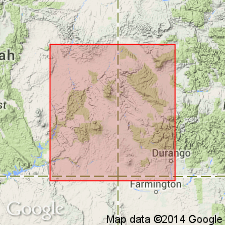
- Usage in publication:
-
- Barker Creek Substage
- Modifications:
-
- Revised
- AAPG geologic province:
-
- Paradox basin
- Black Mesa basin
- San Juan basin
Summary:
Revised from an informal subsurface pay zone within the Hermosa Group (or Hermosa Formation) to lower of four substages of Four Corners Stage (new) in Four Corners area of southeast Utah, southwest Colorado, northwest New Mexico, and northeast Arizona. This substage is the middle of the three substages of the Four Corners to be assigned to the Paradox Formation of the Hermosa Group. Barker Creek is shale bounded and is nearly time-equivalent across broad areas of the Colorado Plateau. Unit is easily recognized by use of mechanical and sample logs, and fusulinids (FUSULINA INSOLITA). Is the oldest Desmoinesian substage defined; older than Akah Substage (revised) of Four Corners Stage. Age is Pennsylvanian (Desmoinesian). Report includes diagrammatic cross section, nomenclature chart.
Source: Modified from GNU records (USGS DDS-6; Denver GNULEX).

- Usage in publication:
-
- Barker Creek production interval
- Modifications:
-
- Overview
- Dominant lithology:
-
- Shale
- Anhydrite
- Dolostone
- Halite
- AAPG geologic province:
-
- Paradox basin
Summary:
Barker Creek production interval. Is the 2nd (of 5, ascending) production interval in the Paradox Member (Atokan(?) and Desmoinesian) of the Middle and Upper Pennsylvanian Hermosa Formation (Atokan, Desmoinesian, Missourian, and Virgilian) in the Paradox basin of southeast Utah and southwest Colorado. Overlies Alkali Gulch production interval. Underlies Akah production interval. Includes evaporite cycles 20-10 (ascending).
"The base and top of the Paradox Member of the Hermosa Formation is usually defined by the first and last halite beds. In the deep part of the Paradox basin, the member consists of 29 identifiable evaporite cycles (Hite, 1960), and its maximum depositional thickness was probably about 7,000 feet (2,130.9 m). These cycles are bounded by disconformities and when complete the sequential order from the base upward is (a) anhydrite, (b) very silty fine grained dolomite, (c) silty calcareous black shale, (d) silty fine grained dolostone, (e) anhydrite, and (f) halite with or without potash salts. With the exception of the black shale unit, all of the elements of the cycle were deposited in response to salinity changes in the brine basin. In the deep part of the Paradox basin, the cyclical sequence consists of up to 80 percent halite. Going from basin deep to basin shelf, the amount of halite in the cycles diminishes while the percentage of dolostone and anhydrite increases."
Source: Modified from GNU records (USGS DDS-6; Denver GNULEX).
For more information, please contact Nancy Stamm, Geologic Names Committee Secretary.
Asterisk (*) indicates published by U.S. Geological Survey authors.
"No current usage" (†) implies that a name has been abandoned or has fallen into disuse. Former usage and, if known, replacement name given in parentheses ( ).
Slash (/) indicates name conflicts with nomenclatural guidelines (CSN, 1933; ACSN, 1961, 1970; NACSN, 1983, 2005, 2021). May be explained within brackets ([ ]).

